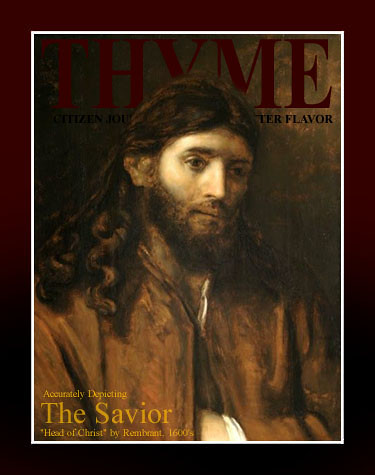
Volume V, Issue VIII
Rembrandt Harmenszoon van Rijn depicted Christ in the workaday clothes of a medieval artisan.
Accurately Depicting the Savior
There is a recurring vision somewhere in my subconscious, where having reached Heaven, I see Jesus in all His glory. Falling on my face, I am overwhelmed. After a while, His hand softly touches my shoulder as He bids me rise: "Come see what I'm working on." He says and then we walk to His workshop.
So many times I have visited an artist or a craftsman, and received that blessed invitation to enter the place where they create. It is an honor to be cherished, especially when a Master invites you as a fellow artisan. Such is the feeling of Christ's invitation in my dream.
Prior to Rembrant, the Seventh Century Master, artists routinely depicted Christ with crisp European features, either as a very heroic figure or in great agony. [1.]
In 1631, Rembrant moved from his hometown of Leiden, The Netherlands, where he was born in 1606, to the port city of Amsterdam, where he purchased a house in the city's Jewish Quarter.Ten years later, he was using the Shepardic Jews in his neighborhood as models. Since Jesus lived in the Middle-east and not Europe, Rembrant's portrayals strike a strong chord of reality in their composition.
The painting above has Jesus wearing the workaday clothes of a medieval artisan. You can just imagine the smells of the workshop still lingering in those clothes. I've met a few stonemasons who's honest features remind me of this picture.
Depicting Messiah has long been a challenge to the serious artist, [2.] and the theologian as well! There seem to be a lot of thoughts about who Christ is. Some of them seem as overworked as the paintings. Scripture gives us a good basis for knowing Christ's nature though. Ironically, it is two English scholars who give us some of the better word portraits. Clive Staples Lewis [3.]and John Ronald Reuel Tolkien [4.] both wrote great depictions.
Lewis portrayed Christ in the character of Aslan, the Lion of Judah. Tolkien's Aragorn (think of the book character more than the movie one here), also displays characteristics of the Redeemer.
Today, more than ever, it behooves us to present as honest a picture of Christ as we can. Much of our society puts little value in our faith, but are they perhaps looking at an incorrect picture? A faulty rendering can discredit something that is actually of great value! [5.]
Looking at the lives of John Newton, William Wilberforce, Florence Nightingale, Charles Dickens, William H. Howland, George Müller and a host of others actually reads like a companion volume to the Hall of Faith described in Hebrews 11. Their stories and their testimonies must be honestly examined before we discard the Faith that moved them. [6.]
This week the 'other' weekly news magazine presents Marco Rubio [click to read] as 'Savior' of the Republican Party. We at THYME would like to gently suggest that the term is greatly overused when referring to political figures.





6 comments:
How crucial it is to read about the lives of true believers through the centuries!
Yes!, and how crucial it is for every believer who understands IMAGO DEI to seek to accurately portray our Savior in his or her own life! A heroic task, to be sure, but it is G-d's Spirit who empowers.
Bob, this post is outstanding!! In fact, I have been working on a sermon series for later in the spring about the exact same topic... and I am marking some of your thoughts to be quoted. Thank you for shining a bright light in the dark world. Love you and praying for you friend.
Also, I loved to read Ginny Kirk's comment and your reply. Amen!
Thank you!
A Great Comment from THYME Facebook:
"I love Charles Dickens work, but wouldn't put too much into his view of Christ. Dickens denied the Divinity of Christ, considering him to be nothing more than a good moral teacher."
Indeed, Charles Dickens is a study in contrasts, much as the Victorian era itself. While the Victorian era saw a great rise in the influence of Christian principles, it also produced William Ernest Henley's Invictus,
Out of the night that covers me,
Black as the pit from pole to pole,
I thank whatever gods may be
For my unconquerable soul.
In the fell clutch of circumstance
I have not winced nor cried aloud.
Under the bludgeonings of chance
My head is bloody, but unbowed.
Beyond this place of wrath and tears
Looms but the Horror of the shade,
And yet the menace of the years
Finds and shall find me unafraid.
It matters not how strait the gate,
How charged with punishment the scroll,
I am the master of my fate:
I am the captain of my soul.
To be sure, Dickens was influenced by both Christian ideals and the Humanism of his time.
Post a Comment